
Since lactate is produced in the muscle and varies according to the effort level, it reflects best what is happening in the muscle. The production of lactate tells us how much the anaerobic system and the aerobic system is involved. So, the amount of lactate in the blood and the corresponding work effort are an indication of how well each of these systems is developed. Thus, lactate testing provides a clear advantage over other types of testing because it can assess the effectiveness of each of these systems. This is not true with other measures which don't tell you what is happening in the muscles or how each energy system is contributing to exercise. This is the major distinction between a lactate testing system and other testing systems.It is not only important to develop as much as possible the aerobic and anaerobic systems but they also have to be well balanced in order to produce optimal performance. This balance will differ by sport and by event within each sport. Unless the coach or athlete knows how each system is performing, achieving this balance is at best a guess.
While lactate levels are the best measure of workout intensity, lactate information has until recently been very expensive and difficult to get. It was not available to coaches unless they tested their athletes at an exercise physiology lab. Because of this coaches and sports physiologists have devised other ways to approximate the information that lactate testing provides and using heart rates was one of these methods. Many coaches instruct their athletes to use heart rates as a surrogate for lactate levels to guide their training. However, we will show that heart rates cannot provide the key information necessary to optimize training. And since lactate measures are now relatively inexpensive, they are not only the most effective but also cost-efficient markers that inform the coach about the physical condition of athletes and the effectiveness of their training.
As a consequence, every minute the athlete spends on training is focused on what is really needed. The athlete avoids unnecessary training workouts and therefore minimizes the risk of injuries.
As a consequence, training programs will be adjusted to the athlete's unique metabolic characteristics.
As a consequence, we learn about the training method that works best with that athlete.
A single lactate test provides a lot of important indications for training. However, the ultimate goal of lactate testing requires more subsequent tests, appropriately timed. A regular evaluation of actual training (stimulus) and the lactate test results (response) provide the real benefit of lactate testing and allows the coach or athlete over time to determine each athlete's "best training practices".
We have placed great importance on INCREASING TRAINING EFFICIENCY. This requires good documentation of all the training you completed. Each athlete's training workouts have to be detailed by volume and intensities where possible. The athlete should also record personal sensation (for example, perceived exertion) and other aspects that are not strictly related to training but which may affect response to training (for example, mental and/or health status, sleep quality and quantity, other daily activities). All should be noted in a training book.An athlete needs regular medical tests (e.g. deficiency of minerals like Mg, Fe,.., presence of small infections, etc....) as well as a physio-therapeutic check-up (misbalance of strength and flexibility of muscle groups, misbalance of joint mobility, persistent muscle stiffness, etc....).
Heart rate observations such as morning heart rate, heart rate at standard intensities, maximal heart rate and recuperation of heart rate, are very useful data to assess the extent of a positive and constructive reaction of your body to training. Heart rate information is an excellent indicator of negative training response and we will shortly discuss when heart rate information is valuable.
We are making the case for the importance of lactate testing here. The following table indicates the ease of use and validity of lactate testing and several other testing methods commonly used by coaches to gather information on the training process.
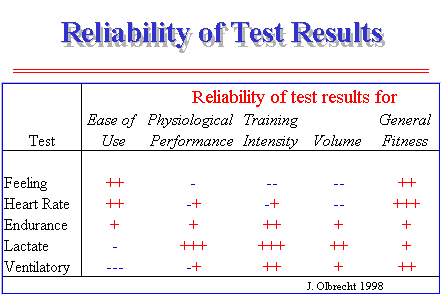
Heart rate information is a excellent indication of the general fitness of an athlete. It will also indicate other stresses that are affecting athletes and their training including impending illness and fatigue. Thus, heart rate testing is a very useful parameter for monitoring the reaction of the athlete's body to training and its interaction with the environment. Unusual heart rates are an indication that the body is being affected adversely by other variables (such as fatigue, diet, infections and environmental variables like temperature, rain and altitude). Normal heart rate response tells the athlete that the training and the body are in harmony.Heart rates are therefore a good measure of whether the body is accepting the workout and will adapt as desired. It is impossible to measure all the variables that will affect a workout. If the heart rate response is normal, it means that the body is responding as expected. If the heart rate response is not normal than something is probably interfering negatively with the training.
While extremely useful for monitoring the response of the body to training, heart rates have many limitations when applied to the intensity of a particular exercise, an overall workout or a training program.
The use of heart rates to guide training lacks scientific validity. Many have tried to relate heart rates to the metabolic characteristics of a specific effort or exercise. There is no doubt that the heart rate increases when an athlete works harder, but the physiological significance of a given effort can not be deduced by means of heart rate monitoring.
- Heart rate can not provide information about aerobic and anaerobic capacity performance.
- Heart rate can not provide information about the aerobic and anaerobic contribution of a training exercise.
- Heart rate can not accurately characterize different types of exercises/sets within a training session (it provides only an approximation.)
- Changes of heart rate over time at the same effort don't tell you what the underlying physiological adaptation is.
- Heart rate therefore does not allow for an accurate assessment of the training effectiveness over time and thus cannot tell the athlete or coach which aspects of a training program are having a positive or negative influence on training adaptation.
Evidence for these statements comes from several studies. Some examples that have examined heart rate and training are below. There are additional examples on the Secrets of Lactate CD-ROM..
Conconi Test - There is no evidence that one of the most popular heart rate tests, the Conconi-test or the Conconi deflection point, represents the lactate threshold. As shown in the next graph, the speed at the Conconi deflection point (Conconi threshold) differs clearly from the lactate threshold for this group of runners (if both thresholds would be identical, then all points have to be located on or near the diagonal line in the graph). Similar results were found for swimming and cycling even when the new adjusted Conconi test was considered in the study.
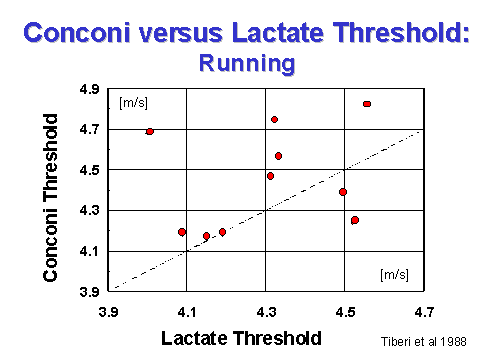
We've also asked cyclists to perform 30 minutes constant efforts at 100, 90, 80, 70 and 60% of the Conconi-threshold. Lactate was measured several times during each effort in order to verify whether or not the athletes attained a lactate steady state. When the 30 minute constant load pace was between 60 and 70% of the Conconi-threshold the lactate levels were between 1.5 and 6 mmol/l and every athlete maintained a lactate steady state. At a work load between 70 and 80% of the Conconi-threshold, lactate readings were between 2 and 9 mmol/l. However, 36% of the athletes were unable to maintain a lactate steady state. This means that 36% of the athletes have surpassed their lactate threshold but were still well below the Conconi indicated threshold. The percentage of athletes that were not able to work at a lactate steady state increased further to 52 and 83% when the work load was set at 80-90% and 90-100% of the Conconi threshold respectively. The obvious conclusion is that the Conconi threshold is not a maximum steady state lactate level for most athletes.
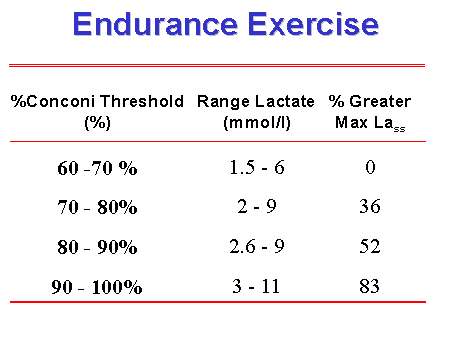
The following chart indicates why it is not possible to identify the energy contribution of the different systems by heart rate. A small range of differences in heart rate can correspond to a large difference in physiological significance of the effort. A runner was asked to run 5 different 28 minutes workouts at a constant speed. Each 28 minute run was done at the same time on different days and at different speeds. Enviromnental conditions were identical since the runs took place on a treadmill in lab. Between the least extensive (easy) and most intensive (hardest) load, we observed a difference of only 9 beats/min. corresponding to a lactate difference of 5 mmol/l. This small range of heart rate corresponded to dramatically different contributions by the aerobic and anaerobic energy systems.
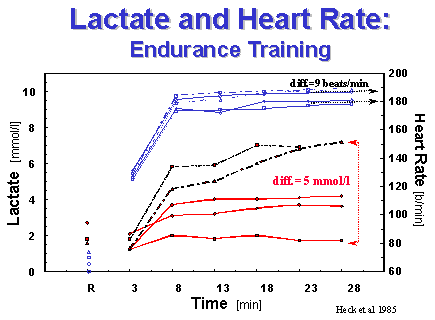
If non-physiological factors such as weather or surface affect heart rate (easily ±6 beats) it is clear that the determination of training intensity by heart rate is very unstable and variable and therefore not accurate and reliable.
The following chart shows a difference of about 6 beats per minute for low work loads (<4mmol/l) on woodlands and a cinder track depending on whether it was wet or dry. This means that there is a difference in physiological significance of training at the same heart rate in wet or dry weather for these two surfaces. This is probably due to better cooling of the body in the wet weather.
The decrease in heart rate in the wet environment disapeared if the exercise was performed on grass. The fact that the athlete has to be more attentive when running on wet grass may explain the counteraction of a decrease of heart rate by a better cooling environmental condition. The increase in the heart rate on the wet grass was probably due to an increased mental stress from running on a slipery surface.
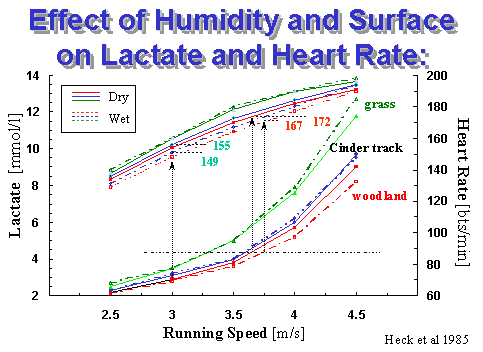
These findings are not unusual since the heart rate reflects much more than just the demand for oxygen by the muscles.
During exercise, heart rate is also driven by many processes that protect the body. For example, heat is a danger linked with endurance sports. The body reacts to heat by increasing the circulation of blood so that it can be cooled down better when more blood reaches the skin. Hence the heart will beat faster to move the blood to this relatively cooler part of the body. This is extremely noticeable during the first days of warmer weather.Another stimulation of heart rate comes from stress. Stress can be positive since it prepares the body to perform at a higher level. But it can also be negative if this stress originates from a catabolic origin (disturbing/destructive) such as illness, pain, overloaded muscles, non-heameostasis etc. In such a catabolic situation, even the best training program will cause your conditioning to deteroiate rather than build up. It is therefore very important to detect this catabolic status as soon as possible and to reduce or halt your training program immediatley. Consequently, heart rate observations, such as morning heart rate, heart rate at standard intensities, maximal heart rate and recuperation of heart rate, are very useful observations to assess if you have to cut back on your training program.
This second characteristic of heart rate is used in the next section to show how an athlete can help read his body by monitoring his morning heart rate.
Despite the limitations of heart rate monitoring mentioned above, a heart rate monitor has many valuable uses. We mentioned above that heart rates are the best measure of the body's reaction to a workout. Consequently a triathlete should contnually record heart rate information as part of their training log in order to compare responses over time to training and the environment.The following chart shows how a heart rate monitor can be used to tell if the body of the athlete is ready to react constructively to training. The morning heart rate (MHR) was measured before, during and after three different training camps at altitude. (Morning heart rate is measured 1 minute before leaving your bed � this to avoid the influence of respiration on a low heart rate) The chart indicates that:
- During the first days of arrival at altitude this athlete's MHR increased compared the MHR at sea level. The higher the training camp, the longer it took before MHR became comparable with the normal MHR at sea level.
- An upper respiratory tract infection was indicated by MHR 4 days before symptoms of the disease were observed (middle chart). During the days before the infection was observed we could not known the reason for the catabolic signal but training was reduced in order to give the organism more room to overcome this internal problem. The athlete returned to good health sooner than if he had continued training and only stopped when the infection was diagnosed by more traditional symptoms.
- Also an accumulation of fatigue due to training can be the cause for a rise in MHR. But once again, even if we didn't know the reason for this catabolic status of the body we still reduced training.
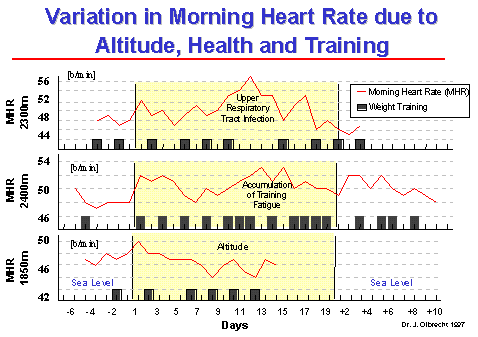
Heart rates and lactate are two very different measures of the body's reaction to exercise. Lactate reflects what is happening in the muscles and is the best measure of the development of the muscle's energy systems. Heart rates are a much better measure than lactate of the body's overall fitness and reaction to training. You can use the analogy of a thermometer and a barometer. Both are measures of the weather but tell you very different things. Together they provide the weather forecaster with much more information than either one alone. However, if you used one to replace the other you will sometimes get the right information but more often than not you will make a mistake. Often the mistake can be costly.
As a consequence the cost in time from the methodology used to determine a reliable anaerobic threshold (MaxLass) is not offset enough by the usability of this information for training efficiency. There is neither scientific proof or an argument from a training science perspective that a training set at the aerobic or anaerobic threshold has any advantage over a good balanced program of different types of training. Therefore the determination of a aerobic or anaerobic threshold should be reserved for academic study approaches.
Questions, Comments and Ordering Information:
1-800-462-2876 (U.S.A. and Canada)
1-914-747-8572 | 1-914 -741-5623 (fax)
email: info @ lactate.com